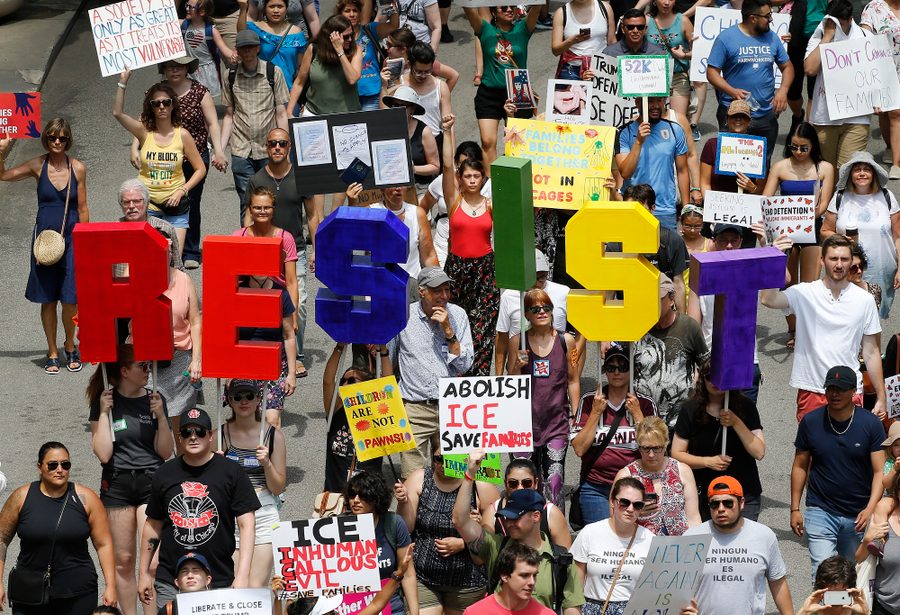How Police "Gang Databases" Are Being Used to Wage War on Immigrants
Wearing a certain colored hat or sporting the wrong tattoo can be enough to get somebody in the system—and eventually deported.
Maurizio Guerrero

CHICAGO — Wilmer Catalan-Ramirez had lived in the United States for more than 10 years when Immigration and Customs Enforcement (ICE) agents entered his home and forcefully arrested him without a warrant in 2017. He spent the next 10 months in the McHenry County Adult Correctional Facility. He was never charged with a crime and was released in January 2018.
The Chicago Police Department had erroneously entered Catalan-Ramirez’s name into its database of gang members, then shared that information with ICE, which acted on the bad intelligence. Federal immigration authorities can access similar secret gang databases around the country. Critics say the databases rely on flimsy evidence and all but criminalize being a young person of color.
And if the Biden administration’s stated immigration priority of cracking down on criminal organizations is any indication, the practice may be here to stay.
“It is not surprising,” says Jane Shim, senior policy attorney at the Immigrant Defense Project, a nonprofit working to expand migrant rights. “It was disappointing, however. … There has been so much research and organizing and advocacy around [gang] databases and all of their problems, their inaccuracies, the really problematic ways they are used by both law enforcement and immigration.”
Often all it takes for a Black or Brown person to be added to a gang database is to stand on a specific street corner, have a certain tattoo or meet with a suspected gang member. Once in the database, they are officially “a threat to public safety.” If their immigration status is in question, they become a deportation priority.
“Identifying certain categories of people who we [as a society] are comfortable with targeting and putting through this really harmful, cruel process of deportation and detention is kind of the backbone of the modern immigration system,” Shim says.
The Policing and Social Justice Project at Brooklyn College reports that, between 2013 and 2018, more than 17,000 people were added to New York City’s gang database, 98% of whom were Black or Latinx. A 2019 Chicago Office of Inspector General’s report found that 95% of individuals designated as gang members during arrests in the city were Black or Latinx. The names in Boston’s gang database are 90% Black or Latinx, according to records obtained by the ACLU of Massachusetts in 2019.
Kerry Doyle, a Boston attorney and former chair of the New England Chapter of the American Immigration Lawyers Association, says that information from local gang databases is often too unreliable to hold up in criminal cases, but “immigration judges take it as the truth.”
In 2017, Doyle represented a young Central American migrant who was detained in the United States for 30 months without criminal charges. Her client’s mistake was socializing with alleged gang members.
Gang databases have drawn criticism from national civil rights groups including Human Rights Watch and Detention Watch Network, which co-signed an April 1 petition calling on the Department of Homeland Security to end its discriminatory “prioritization” practices.
Data from the Transactional Records Access Clearinghouse (TRAC), a research organization at Syracuse University, finds ICE detained and booked into civil immigration detention 62% fewer people in February (1,970), the first whole month of the Biden administration, than in January (5,119), the last of the Trump administration. But gang databases could still play an outsize role in the future of immigration. The American Dream and Promise Act, which passed the House in March, would open a path to citizenship for 2.5 million undocumented immigrants — but anyone in a gang database will likely be excluded.
“Legislators have chosen to turn their backs on those who are most harmed by the immigration system,” the National Immigration Project says about the bill. That includes “every Black or Latinx immigrant standing on a street corner with their friends whose name was put in a gang database because of the color of their skin.”
While advocates push the federal government to end the use of these databases in immigration matters, people like Catalan-Ramirez remain vulnerable. Even so-called sanctuary cities like Boston offer federal agents access to these unreliable databases.
But in some cities, activist pressure is building. The Boston City Council recently held a hearing on its gang database. And in Chicago, democratic socialist aldermen Carlos Ramirez-Rosa and Rossana Rodriguez Sanchez led a successful campaign to ban city police from cooperating with ICE.
“We are focusing right now on engaging with local representatives and other people in Chicago,” says Xanat Sobrevilla of Organized Communities Against Deportation (OCAD), a group of undocumented activists that campaigned for Catalan-Ramirez’s release. “We are hoping to work to pass [a city] ordinance that would eliminate the local database … to further disconnect this tool from ICE.”
Maurizio Guerrero is a journalist based in New York City. He covers migration, social justice movements and Latin America.









